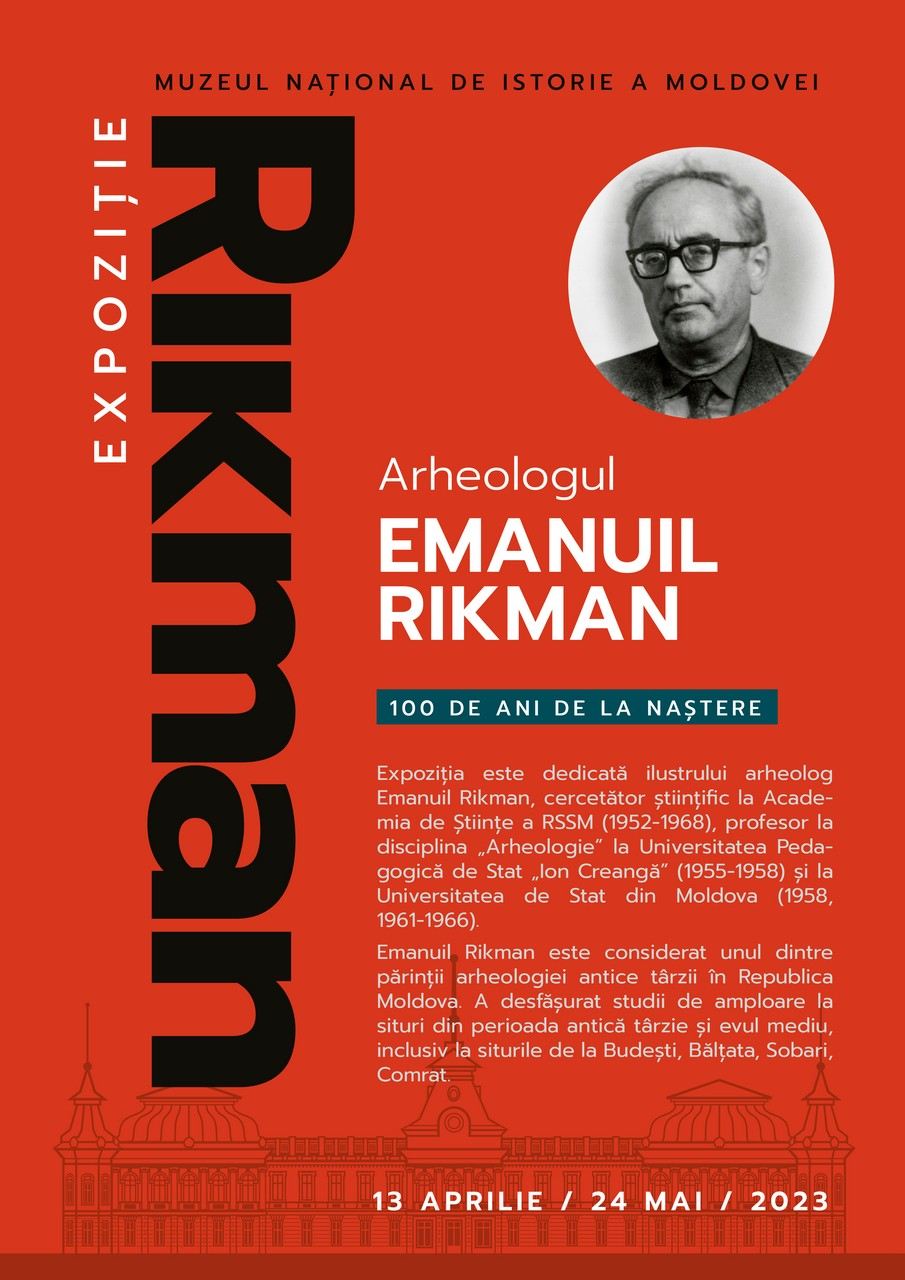 The exhibition is dedicated to the illustrious archaeologist Emanuil Rikman, former scientific researcher at the Academy of Sciences of the Moldovan SSR (1952-1968) and professor of archeology at the State Pedagogical University "Ion Creangă" (1955-1958) and the Moldova State University (1958, 1961-1966).
The exhibition is dedicated to the illustrious archaeologist Emanuil Rikman, former scientific researcher at the Academy of Sciences of the Moldovan SSR (1952-1968) and professor of archeology at the State Pedagogical University "Ion Creangă" (1955-1958) and the Moldova State University (1958, 1961-1966).
Emanuil Rikman is one of the fathers of ancient archeology in the Republic of Moldova. He carried out extensive research on the archeology of the Roman era, promoted investigations on the Romanization of the Geto-Dacians, carried out large-scale studies at sites from the ancient period and the Middle Ages, including at the sites of Budești, Bălțata, Sobari, Comrat, Costești, etc.
He promoted studies on traditional Romanian culture in Bessarabia and Northern Bucovina, conducted ethnographic field research in Northern Moldova. He has published more than 110 studies of archeology and ethnography. He contributed to the formation of the archaeological school in the MSSR.
Emanuil Rikman was born on January 10, 1923 in Berdichev, Reg. Zhitomir, Ukraine, died in 1987, being buried in Moscow.
The exhibition "Archaeologist Emanuil RIKMAN - 100 years since his birth" aims to commemorate and pay tribute to the scientist Emanuil Rikman by exposing to the general public some documentary materials related to the fruitful activity of the late researcher and pedagogue.
The exhibition includes 2 types of exhibits: documentary materials related to the personality of Emanuil Rikman and various archaeological pieces discovered by Emanuil Rikman, currently kept in the patrimonial funds of NMHM.
The documentary materials are copies extracted from Emanuil Rikman's personal archive, archaeological reports from the NMHM archive, the scholar's monographs, photographic images from archaeological sites and Emanuil Rikman's ethnographic expeditions on the territory of the Republic of Moldova. Part of the documentary materials for the organization of the exhibition were provided by the Faculty of History of the MSU and the National Archaeological Agency.
The archaeological vestiges on display represent original pieces from Emanuil Rikman's excavations from the sites of Budești, Comrat, Bălțata, Caracușenii Noi, etc. The exhibition presents archaeological pieces made of ceramics, bronze, copper, silver, glass, bone, etc., dated in the II-IV centuries, including pots-jars, cups, jugs, bowls, Roman amphorae, brooches, beads, pendants, objects toilet etc.
The exhibition "Archaeologist Emanuil RIKMAN - 100 years since his birth" can be visited during 13 April - 24 May 2023, in the upstairs hall of the National Museum of History of Moldova, 31 August 1989 str., 121A.
 31 August 1989 St., 121 A, MD 2012, Chisinau, Republic of Moldova
31 August 1989 St., 121 A, MD 2012, Chisinau, Republic of Moldova




 The side panels are elegantly decorated with refined cast-iron elements in the Art Nouveau style, displaying the brand name - "Ideal." The Polyglott model, featuring a bilingual keyboard patented in the United Kingdom by Max Klaczko from Riga, Latvia, was produced between 1902 and 1913, marking the first typewriter capable of writing in two languages. The "Ideal Polyglott" typewriter was actively sold in the Russian Empire and gained significant popularity in Poland, Bulgaria, and Serbia.
The side panels are elegantly decorated with refined cast-iron elements in the Art Nouveau style, displaying the brand name - "Ideal." The Polyglott model, featuring a bilingual keyboard patented in the United Kingdom by Max Klaczko from Riga, Latvia, was produced between 1902 and 1913, marking the first typewriter capable of writing in two languages. The "Ideal Polyglott" typewriter was actively sold in the Russian Empire and gained significant popularity in Poland, Bulgaria, and Serbia.




















































